#The Flower Ornament Scripture
Explore tagged Tumblr posts
Text
From “The Flower Bank World” in the Avatamsaka Sutra

The Buddhist Painting of Songgwansa Temple, Suncheon, South Korea (Illustration of Avatamsaka Sutra)
“Then Universally Good also said to the assembly, ‘In the land masses of this ocean of worlds are seas of fragrant waters, as numerous as atoms in unspeakably many buddha-fields. All beautiful jewels adorn the floors of those seas; gems of exquisite fragrances adorn their shores. They are meshed with luminous diamonds. Their fragrant waters shine with the colors of all jewels. Flowers of all kinds of gems swirl on their surfaces. Sandalwood powder settles on the bottom of the seas. They emanate the sounds of Buddhas’ speech. They radiate jewellike light. Boundless enlightening beings, holding various canopies, manifest mystic powers causing the adornments of all worlds to appear therein. Stairways of ten kinds of precious substances are set out in rows, with balustrades of ten kinds of jewels surrounding them. White lotuses ornamented with jewels, as many as atoms in four continents, are spread over the waters, in full bloom. There are unspeakable hundreds of thousands of billions of trillions of banners of ten precious elements, banners of belled gauze of raiments of all jewels, as many as sand grains in the Ganges river, jewel flower palaces of boundless forms, as many as sand grains in the Ganges river, a hundred thousand billion trillion lotus castles of ten precious substances, forests of jewel trees as many as atoms in four continents, networks of flaming jewels, as many sandalwood perfumes as grains of sand in the Ganges, and jewels of blazing radiance emitting the sounds of Buddhas’ speech…”
--From book five “The Flower Bank World” in the The Flower Ornament Scripture (Buddhāvataṃsaka Sūtra), translated from Chinese by Thomas Cleary. The various sutras were originally composed in Sanskrit and compiled and translated into Chinese in the 5th century CE. Thomas Cleary’s English translation is based on the Chinese translation done by the Khotanese monk Shikshananda (652-710 CE), who translated it at the request of the Tang Empress.
I stumbled upon this sutra in the back of a book that included a ‘glossary of buddhist terms’ while at a Zen meditation retreat. Flower cosmology? That sounds like my shit. Since I didn’t have my phone I wrote the name down on a piece of paper and slipped it into my backpack. It really is as incredible as I imagined it to be.
“Alan Fox has described the sutra's worldview as ‘fractal’, ‘holographic’, and ‘psychedelic’”—yes.
“In the Huayan school, the teaching of interpenetration is depicted through various metaphors, such as Indra's net, a teaching which may have been influenced by the Gandhavyuha chapter's climax scene in Vairocana's Tower. Indra's net is an infinite cosmic net that contains a multifaceted jewel at each vertex, with each jewel being reflected in all of the other jewels, ad infinitum. Thus, each jewel contains the entire net of jewels reflected within.”
#Avataṃsaka Sūtra#Avatamsaka Sutra#flower garland sutra#Hwaeom#Kegon#Huayan Buddhism#Huayan#chan buddhism#Xianshou#water#buddhism#religion#mysticism#Thomas Cleary#literature#philosophy#metaphysics of flowers#The Flower Ornament Scripture#Buddhāvataṃsaka Sūtra#Buddhāvataṃsaka-nāma-mahāvaipulya-sūtra#Sanskrit
70 notes
·
View notes
Note
So, what IS the Samadhi Fire/True Fire of Samadhi? It can't be an average flame if it can take out Sun Wukong himself in JttW and the name sounds like it means something, but I can't find any context when I look it up.
Journey to the West states that Samādhi fire is not like earthly or heavenly flame. It is something more. Part of a poem in chapter 41 reads:
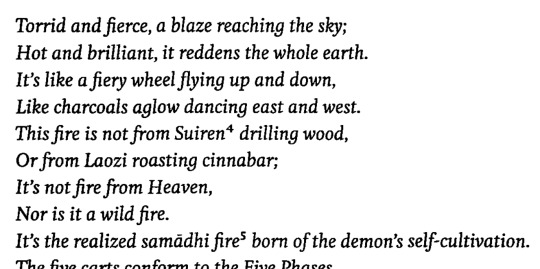
(Wu & Yu, 2012, vol. 2, p. 225)
The general concept of Samādhi (Sk: "concentration"; Ch: sanmei, 三昧) refers to an advanced level of meditation where one can "establish and maintain one-pointedness of mind on a specific object of concentration" (Buswell & Lopez, 2014, p. 743). Some Hindu and Buddhist sources associate it with a spiritually cleansing flame. One example comes from the Gaṇḍavyūha section of the Avataṃsaka Sūtra (Ch: Dafang guangfo huayan jing, 大方廣佛華嚴經; compiled by the 3rd or 4th-century CE).
Sudhana (Ch: Shancai tongzi, 善財童子; i.e. Red Boy), the holy work's protagonist, seeks out 53 teachers in the course of his spiritual cultivation. His ninth instructor, a learned Brahmin named Jayoṣmāyatana (Ch: Shengre poluomen, 勝熱婆羅門; lit: "Victorious Heat Brahmin") is said to have achieved "the light of the concentration [i.e. Samādhi] of adamantine flame" (jingang yan sanmei guangming, 金剛焰三昧光明) (Clearly, 1993, p. 1218). The fire that he produces is so powerful that it scares even the gods and demons. Though, the point of the flames appears to be incineration of the ego and desires and illumination of the mind. Sudhana follows his instructions by throwing himself into the fire, thus gaining a higher level of spiritual knowledge.
Here is a translation of that section of the sutra (warning: it is wordy):
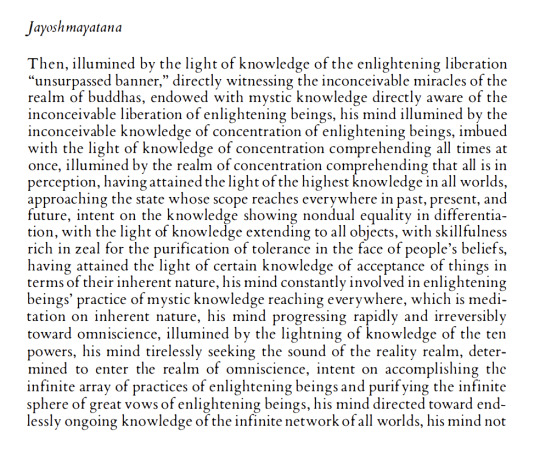
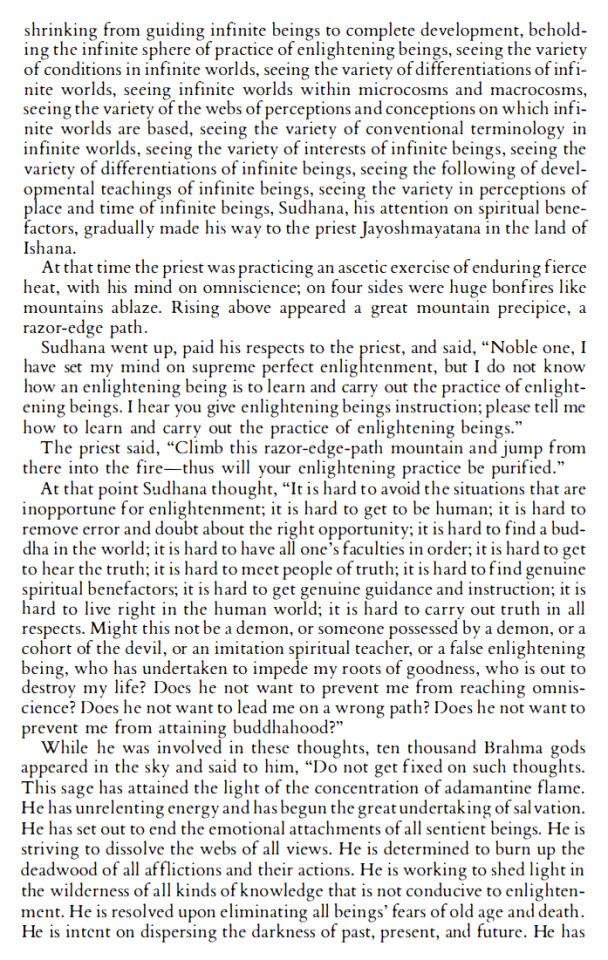
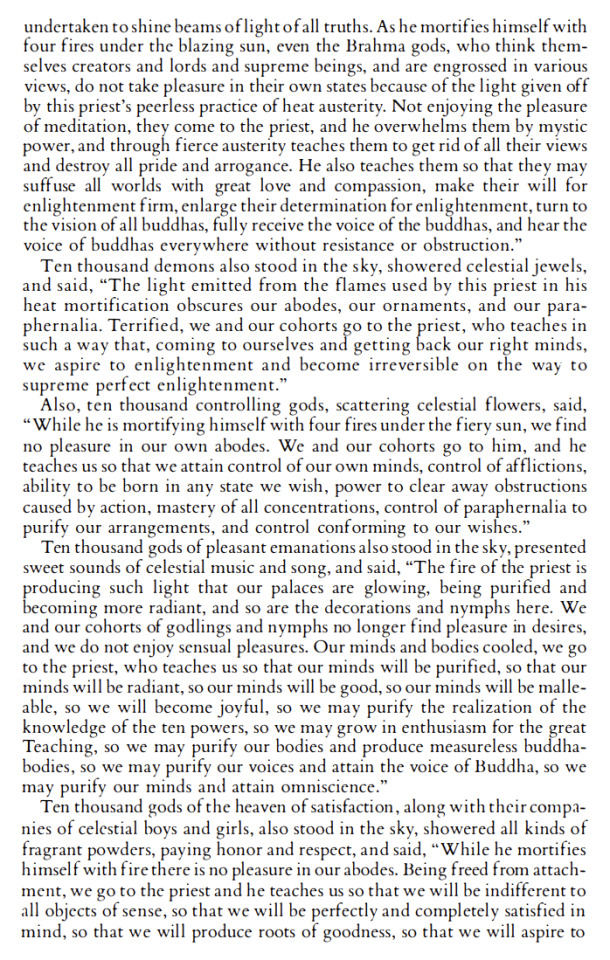
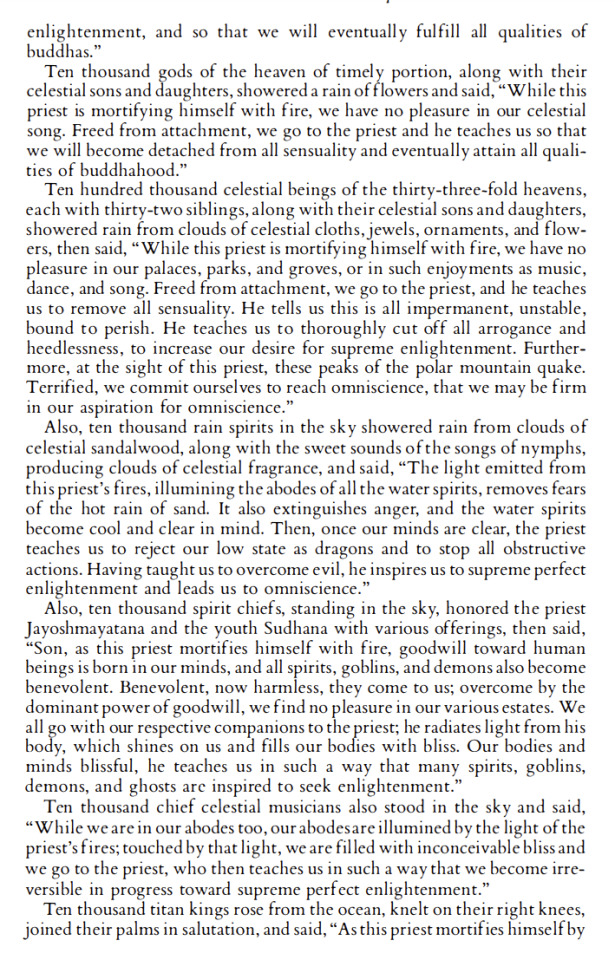
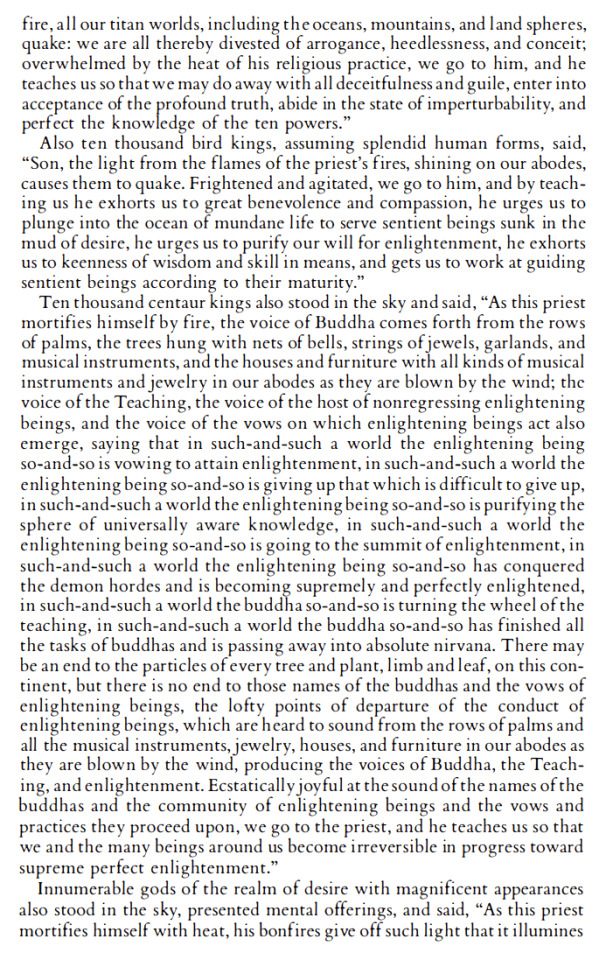
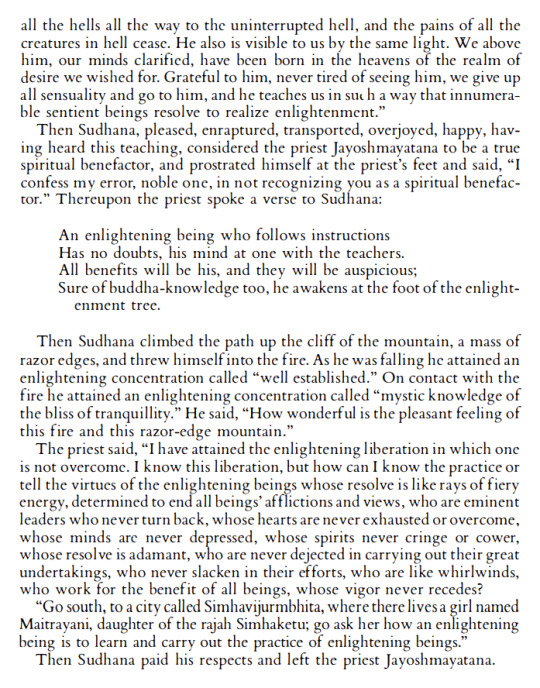
(Clearly, 1993, pp. 1217-1222)

A Song or Ming-era Japanese painting of the fire brahmin and Sudhana.
Sources:
Buswell, R. E. , & Lopez, D. S. (2014). The Princeton Dictionary of Buddhism. Princeton University Press.
Cleary, T. (1993). The Flower Ornament Scripture: A Translation of the Avatamsaka Sutra. Boston: Shambhala.
Wu, C., & Yu, A. C. (2012). The Journey to the West (Vols. 1-4) (Rev. ed.). Chicago, Illinois: University of Chicago Press.
#Samadhi fire#Samadhi flame#Red Boy#Red Son#Journey to the West#JTTW#Buddhism#Hinduism#Samadhi#Lego Monkie Kid#Sudhana#Shancai tongzi#Chinese religion#Indian religion#meditation
105 notes
·
View notes
Text
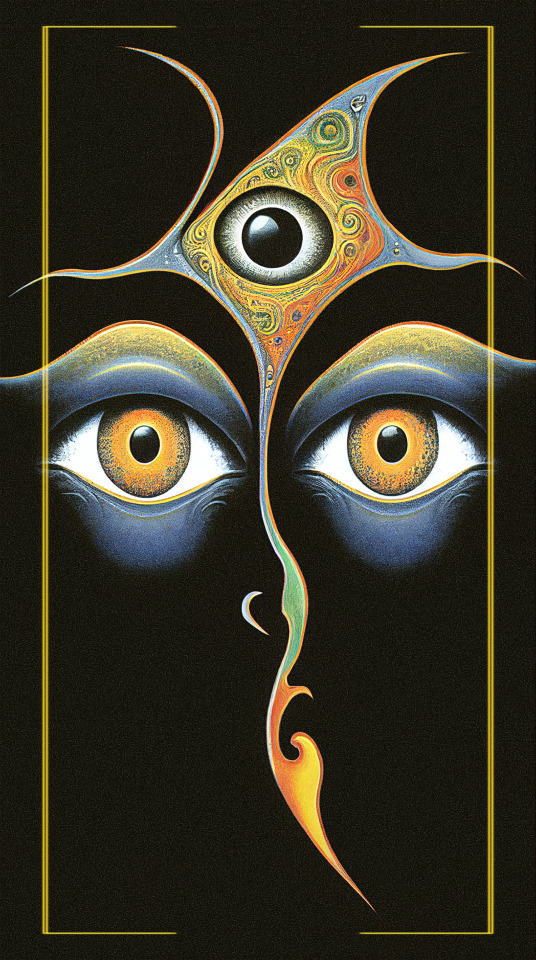
"Meditating with all his heart on Lord Krishna, whose eyes are handsome lotus flowers, whose complexion is a monsoon cloud, whose garments are lightning, who has two arms, who is rich in transcendental knowledge, who wears a garland of forest flowers, who is the supreme controller, who is surrounded by gopas, gopis, and surabhi cows, who rests under a sura-druma tree, who is decorated with splendid ornaments, who stands in the middle of a red lotus flower, and who is served by breezes that have touched the Yamuna’s waves, a person becomes free from repeated birth and death."
This mantra should be repeatedly chanted: "Klim Krishnaya Govindaya Gopijanavallabhaya Svaha"
Lotus Eyes of Krishna Image art by Mahaboka From: Gopala-Tapaniya Upanishad
7 notes
·
View notes
Text
"Srividya: the twists and turns of a tantric tradition : Phil Hine
In the last two issues of my Unfoldings newsletter, I have been engaging in an in-depth analysis of Kenneth Grant’s representation of Tantric mysteries in his books – using his 1999 book, Beyond the Mauve Zone as the main reference point. In support of this series of essays, I thought it would be helpful for those reading the essays to attempt a general overview of the historical development of the Tripurāsundarī traditions, known nowadays as Śrīvidyā. In this first post, I’m going to focus on the roots of this tradition – the Nityā
The term Śrīvidyā is a compound formed from Śrī – an honorific denoting auspiciousness (also an epithet of the Goddess), and Vidyā – a feminine mantra.
Exoterically, Vidyā can denote knowledge or wisdom. The early texts of the tradition do not use this term though, rather, the tradition referred to itself as the traipuradarśana (doctrine of Tripurā) or sometimes, the Saugbhāgyavidyā (Saugbhāgya denotes good fortune, happiness, and success). According to Anna A. Golovkova (2020), the term Śrīvidyā first appears in a fourteenth-century commentary on the Yoginīhṛdaya. The tradition is sometimes referred to as the ‘last sampradāya’ – the most recent of the nine classical Śaiva tantric traditions. The principal or ‘root’ text of the tradition, the Vāmakeśvarīmata tantra has been dated to between the 10th-11th century CE.
The Nityā Tradition
Contemporary scholars have identified the antecedents of the worship of Tripurāsundarī within a lost Kaula tradition, known as the Nityā (‘eternal’). Much of what is known about this tradition has been gleaned from references in tantric scriptures.
As Golovkova points out, there are no references to the Nityā in works of the Trika tradition, but there are in the later Kubjika tradition, such as the Kubjikāmata (tenth century), the vast Manthānabhairava Tantra, and the Ciñciṇīmatasārasamuccaya. Only one scripture of the Nityā has survived – the Nityākaula. Chapter 30 of the Manthānabhairava Tantra which largely concerns the rules for writing and transmitting scripture, names the Nityākaula as one of the scriptures it considers valid.
In the Nityā tradition, the principal goddess is Kāmeśvarī, and her consort is the god of love, Kāmadeva, accompanied by eleven subordinate Nityā goddesses (see this long essay for some related discussion of Kāma, his weapons, particularly the Sugarcane Bow).
These Nityā goddesses are placed around a triangle (identified with the yoni) and intermediate points of an enclosing hexagram. The points of the triangle are identified with three pīṭhas (seats) of the goddess: Jālandhara, Pūrṇapīṭha, and Uḍḍiyāna. The fourth pīṭha, Kāmarūpa, is the centre of the triangle and the abode of Kāmeśvarī. Hence Kāmarūpa is considered to be the greatest of the śaktī pīṭhas.
The Kālikāpurāṇa (c.10-11th century) gives a lengthy description of Kāmarūpa (Assam) as a kind of divine wonderland, where death cannot enter; where there are no temples or images, but the deities are present as mountains, ponds, trees, and streams. After the terrible events of Dakṣa’s sacrifice, Śiva’s spouse, Satī took her own life. The grieving Śiva carted her body about with him until the other gods sliced up her body. The goddess’ yonimaṇḍala fell at Kāmarūpa, on Mount Kāmagiri (mountain of desire).
The Kāmākhyā temple complex is a centre of Śakta Tantra, and the goddess Kāmākhyā is worshipped there in the form of a yoni-stone, submerged in a natural stream, located in an underground chamber beneath the temple. According to the Kālikāpurāṇa, bathing in the waters of this stream results in release from rebirth and instant liberation. The Kaulajñānanirṇaya says that all of the women who reside in Kāmarūpa are Yoginīs who can reveal secrets and grant siddhis.
Kāmeśvarī is described as being of red hue, bearing weapons the weapons of Kāmadeva (noose, goad, bow, flower-arrows), and extensively ornamented (see these posts for some related discussion of ornamentation).
According to Golovkova, many of these elements appear in the Vāmakeśvarīmata (and later scriptures) – such as the goddess’ red hue; her bearing of the weapons of Kāma; the triangle and her triadic form; and her identification with the pīṭhas. Although, in the later tradition, Kāma has been supplanted by Śiva, there are many references to Kāma – particularly in the names of the groups of subsidiary goddesses populating the layers of the Śricakra (here’s a quick tour through the Śricakra).
In her paper, Golovkova gives a very insightful comparison between a passage she has translated from the Nityākaula and a very similar passage from the Vāmakeśvarīmata. Both passages show that the worship of the goddesses necessitates that the (male) adept should, having installed the goddess in his own body using Nyāsa, must dress in red clothing, adorn himself with flowers, smear his body with red unguent, apply eyeliner (collyrium), chew betel and spices, and equip himself with the weapons of Kāma. He is trying to further identify himself with the goddess by taking on her physical characteristics. Similar practices, albeit directed at emulating the fury of Bhairava are described in the mudrākośa section of the Jayadrathayāmala. This kind of ritualistic male performance of femaleness can be found in early tantric scriptures -even those of the orthodox Śaiva Siddhanta.
The attraction of female partners – human, or otherwise (nāgas, gāndharvas, yakṣinīs, for example) is a core concern of the Nityākaula, and again, as Golovkova shows, this is a focus of the Vāmakeśvarīmata. I concur. There is a great deal of emphasis on not only attracting women but gaining wealth, and power, destroying enemies, and obtaining siddhis in the Vāmakeśvarīmata – and relatively little directed towards what we think of as spiritual liberation.
Locating female agency is always a tricky proposition in regards to the tantras. In this respect, Golovkova argues that in these early scriptures, women have no agency at all – they are highly sexualized, mere objects for the male ritual gaze and acquisition, subjects of practices that aim at attracting and subordinating them."
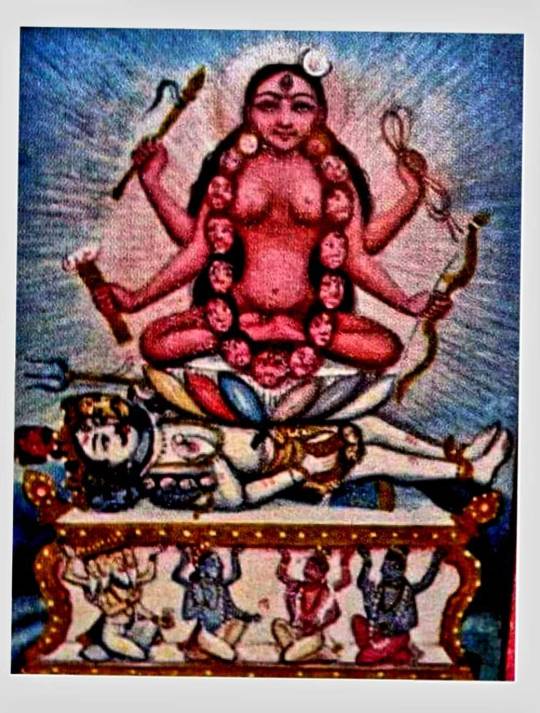
Sources:
- Bagchi, P.C., Magee, Mike. 1986. Kaulajnana-nirnaya of the The School of Matsyendranatha. Prachya Prakashan.
-Dyczkowski, Mark S.G. (2009). Manthanabhairavatantram Kumarikakhandah (The Section Concerning the Virgin Goddess of the Tantra of the Churning Bhairava In Fourteen Volumes). Indira Gandhi National Center for the Arts and D. K. Printworld Pvt. Ltd.
-Golovkova, Anna A. 2020. ‘The Forgotten Consort: The Goddess and Kāmadeva in the Early Worship of Tripurasundarī’. International Journal of Hindu Studies. https://link.springer.com/article/10.1007/s11407-020-09272-6
-Magee, Mike. 2011. The Mysteries of the Red Goddess. Prakasha Publishing.
-Rosati, Paolo E. 2023. ‘Crossing the boundaries of sex, blood and magic in the Tantric cult of Kāmākhyā’ in Acri, Andrea and Rosati, Paolo E. (eds) Tantra, Magic, and Vernacular Religions in Monsoon Asia. Routledge."
5 notes
·
View notes
Text
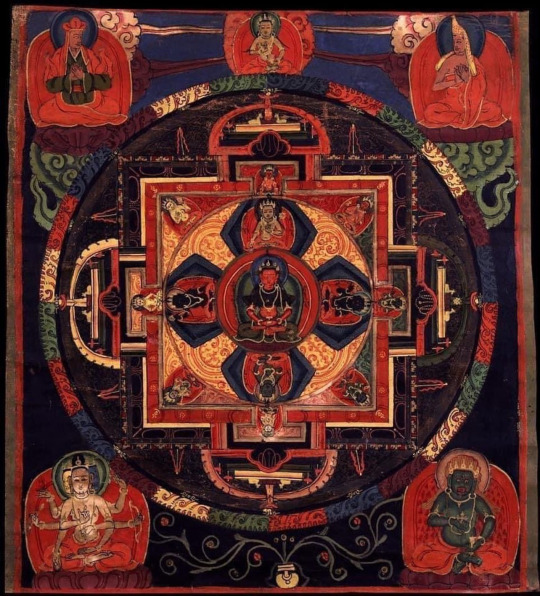
I see as many Buddhas as atoms in a hundred million lands
In one moment of consciousness, Showing the world in many ways Tranquility in an instant.
Avatamsaka Sutra - Flower Ornament Scripture
The Mandala is of Amitabha/Amitayus Buddha Sarvadurgati Tantra
7 notes
·
View notes
Text
Kuukai and the Rishukyo: It’s meaningless- This guy is an idiot (Esoteric Buddhism-1)

The sect that Kuukai founded is a major sect of esoteric Buddhism called Shingon Buddhism, and its temples are scattered throughout Japan. One time, I went to see a Shingon sect festival in my area. One word: gorgeous! It was a truly spectacular ceremony that made effective use of lanterns.
Now, after looking at it and thinking about it, I concluded that it was "too gorgeous!!" The Shingon sect seems to hold extravagant festivals without exception. Looking back, the scene when Kukai received the transmission ceremony from his master Huiguo in Chang'an, the capital of the Tang Dynasty where esoteric Buddhism was popular, can only be described as gorgeous. Surrounded by brightly colored ornaments, Kukai threw flowers at the Buddhas, and childishly, the Buddha would unite with the guardian deity of the Buddha whom he had thrown. He became a Tathagata.
If you want to convey the state of enlightenment, a more modest ceremony should be sufficient. Not doing so seems like a desire to "protect the nation," a desire to bypass personal salvation (enlightenment) and become involved in the fate of the nation. Shingon Buddhism is the perfect way to demonstrate the power of the nation. In other words, it's a "bluff".
Another point of contention is the strange description of Rishukyo, one of the fundamental scriptures of the Shingon sect. What it says is that when a young man and woman get to know each other, love develops, and they embrace each other with feelings that reach heaven, they are at the ``bodhisattva level'' (purity). In normal Buddhism, romantic feelings between men and women are usually excluded, so the description in the Rishūkyō stands out.
When it comes to human love, it's normal for two people to end up on the other side, and the scary situation of a love triangle often occurs. The moment a loved one of the opposite sex is abducted by someone of the same sex, the person concerned falls into hell instead of heaven. A bodhisattva quickly turns into a sinner in hell. As someone who has experienced this bitter love triangle, I declare that the Rishukyo sutra is falsehood. Kuukai is an idiot who made this the basic scripture.
Rei Morishia
2 notes
·
View notes
Text
Spaciousness
We may see this world as countries, cities, towns, and people that are divided by lines on a map. But the truth is that this is one world that arose within space, and that will dissolve back into space. And that every being’s body that has ever habited this world is actually made up of it, and that will dissolve back into it. Nothing exists independently.
~ Chamtrul Rinpoche
“What worlds are there herein? I’ll tell you. In these seas of fragrant waters, numerous as atoms in unspeakably many buddha-fields, rest an equal number of world systems. Each world system also contains an equal number of worlds. Those world systems in the ocean of worlds have various resting places, various shapes and forms, various substances and essences, various locations, various entryways, various adornments, various boundaries, various alignments, various similarities, and various powers of maintenance.
I vow that when my life approaches its end, all obstructions will be swept away; I will see Amitabha Buddha, and be born in his land of Ultimate Bliss and Peace. When reborn in the Western Land, I will perfect and completely fulfill, without exception, these Great Vows, to delight and benefit all beings.
Inconceivable, the Buddha’s body holds within it all lands. He is present everywhere, guiding beings and teaching true Dharma.
I can penetrate the future and exhaust all eons in a single thought. In a single thought I completely enter all eons of the three periods of time.
On the tip of an extremely fine hair, appear jewelled lands of past, present and future; lands on hair tips as numerous as dust motes in all lands of the ten directions, I deeply enter, adorn, and purify.
~ The Flower Ornament Scripture: A Translation of the Avatamsaka Sutra
Translation Thomas Clearly

M104, Sombrero Galaxy
10K notes
·
View notes
Text
Radharamanji Mandir – A Divine Gem of Vrindavan
Radharamanji Mandir – A Divine Gem of Vrindavan

The holy town of Vrindavan, located in Uttar Pradesh, India, is a sacred destination revered by millions of devotees of Lord Krishna. Among its many historical and spiritual treasures, the Radharamanji mandir stands out as one of the most significant and spiritually vibrant temples in the region. Also known by its traditional name shriradharaman, this temple attracts thousands of pilgrims every year who come to experience the divine presence and bliss of Lord Krishna in His most enchanting form.
Historical Significance of Radharamanji Mandir
The Radharamanji mandir was established in the year 1542 by the great Vaishnava saint Gopala Bhatta Goswami, one of the six Goswamis of Vrindavan and a direct follower of Chaitanya Mahaprabhu. The temple's most unique feature is its deity, shriradharaman, which is believed to have self-manifested from a Shaligram Shila, a sacred fossil stone worshipped by Vaishnavas.
According to legend, Gopala Bhatta Goswami was gifted several Shaligrams by a South Indian devotee. He worshipped them with utmost devotion. One day, he wished to serve Lord Krishna in His deity form, dressing Him and offering Him ornaments. That night, one of the Shaligrams miraculously transformed into the beautiful form of shriradharaman, fulfilling the saint’s heartfelt desire. Since then, this deity has been worshipped with unwavering devotion at the Radharamanji mandir.
Spiritual Importance of Shriradharaman
The deity of shriradharaman in the Radharamanji mandir is considered to be one of the most exquisite and spiritually powerful forms of Krishna in all of Vrindavan. What makes this deity unique is that it embodies both Krishna and Radha in one form. While there is no separate deity of Radha Rani installed in the temple, it is said that Radha is eternally present in the heart of shriradharaman.
This sacred concept emphasizes the eternal union of Radha and Krishna, a theme central to the philosophy of Gaudiya Vaishnavism. The Radharamanji mandir thus becomes not just a place of worship but a living representation of divine love and eternal companionship.
Architecture and Atmosphere

Although the Radharamanji mandir is not as large as some other temples in Vrindavan, its architecture is deeply captivating. Built in traditional Rajasthani and Mughal styles, the temple showcases beautifully carved pillars, intricate stonework, and a spiritual ambiance that transports devotees to another realm.
Inside the sanctum, the deity of shriradharaman radiates divine charm. The eyes of the Lord seem alive, and His smile is known to melt even the hardest hearts. Devotees often say that a single darshan (viewing) of shriradharaman is enough to fill one’s life with bliss and surrender.
Festivals and Celebrations
The Radharamanji mandir is renowned for its vibrant celebration of Vaishnava festivals. Among them, Janmashtami (the birth of Lord Krishna), Radhashtami, and Holi are celebrated with great enthusiasm. However, the most special occasion is the appearance day of shriradharaman, which falls on Vaishakha Shukla Ekadashi. This day marks the miraculous manifestation of the deity and is observed with grand rituals, singing, and devotional processions.
During these festivals, the Radharamanji mandir is adorned with flowers, lamps, and colorful fabrics. Devotees participate in abhishekams (ritual bathing), kirtans (devotional singing), and offer various sweets, fruits, and garments to shriradharaman.
Preservation of Ancient Traditions
One of the most admirable aspects of the Radharamanji mandir is its adherence to centuries-old traditions. The rituals and daily worship at the temple have remained unchanged since the time of Gopala Bhatta Goswami. Priests still chant the same Sanskrit mantras and perform seva (service) in accordance with ancient scriptures.
This preservation of spiritual heritage makes the Radharamanji mandir not only a religious destination but also a cultural and historical treasure. Visitors often find themselves immersed in the same devotional atmosphere that saints and sages once experienced centuries ago.
A Must-Visit Destination for Pilgrims
For anyone visiting Vrindavan, a trip to the Radharamanji mandir is essential. It is centrally located and easily accessible from other key temples and sites like Seva Kunj, Nidhivan, and Banke Bihari Temple. Despite its popularity, the temple maintains a serene and devotional atmosphere, making it ideal for those seeking spiritual connection and inner peace.
The experience of standing before shriradharaman, hearing the soft sounds of temple bells, and witnessing the sincere devotion of fellow pilgrims is truly transformative. Many devotees return year after year, drawn by the temple’s divine energy and the love of shriradharaman that continues to grow in their hearts.
Conclusion
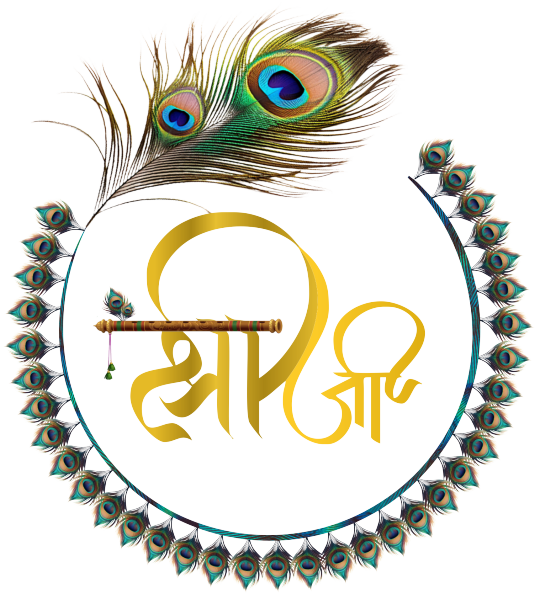
The Radharamanji mandir is more than just a religious site—it is a sacred haven where divine love, tradition, and spiritual truth converge. The presence of shriradharaman, a self-manifested deity worshipped with unbroken devotion for nearly 500 years, makes this temple one of the most important spiritual destinations in Vrindavan and all of India.
Whether you are a seasoned pilgrim or a spiritual seeker, visiting the Radharamanji mandir offers an opportunity to reconnect with the divine and experience the grace of shriradharaman firsthand. Let your journey to Vrindavan be blessed by the enchanting smile and eternal presence of the Lord who resides in this sacred mandir.
0 notes
Text

Happy Ram Navami to all the Hindus out there.
“Rama, the great prophet and ideal of the Hindus, was at the same time the example of a godhead. The character of Rama is said to have been foretold by Valmiki. The training which was given to Rama by a great rishi whose name was Vashishta was to bring out that kingdom of God which is hidden in the heart of man. In this particular respect Rama was not only an ideal for the Hindus of that particular age, but was a model to mold the character of those who tread the spiritual path in any age.
Rama was a prince by birth, but was given to be trained under a sage, where he lived the life of solitude, study, and play all together. He was not only taught to read and write, but he was trained in athletic sports and in all manner of warfare. This shows that the ancient people had education in all directions of life. Rama completed his course of study about the time of the prime of his youth. The story of Rama has been always considered as the most sacred scripture for the Hindus; it is called the Ramayana. The Brahman recites this story in a poetic form to which the devotees of the master listen for hours without tiring. They take it as their religious training.
The most interesting part of Rama's life is his marriage. In ancient times there was a custom that the husband was chosen. This custom came out of the tendency to warfare. At every little trouble the princes of the time were up in arms even in such matters as marriage. In order to avoid war the father of Sita invited all the princes and potentates of his land and gave the right of selection to his daughter. There was a time appointed when they all gathered in the royal gallery adorned in their regal ornaments, decorations, and garbs.
Rama lived a simple life. He had not yet known what princely life means, for he was being trained under a saint, where he ate the same food as the sage did, wore the same simple clothes as the sage, and lived in the woods in solitude. Yet the brightness of the soul shines out even without ornaments.
When Sita entered among this assembly with a garland of flowers in her hands, her first glance fell upon Rama and she could not lift her glance from that ideal of her soul to anyone else, for her soul recognized the pearl in its heart. Sita, without a moment's pause, came immediately and put the garland on the neck of that youth, so simple and unassuming, standing with an innocent expression behind all the shining hosts.
Many marveled at this choice, but many more became as glowing fire with the thought of envy and jealousy. Among them, the one who was most troubled was the king of Lanka, Ravana. For Sita was not only known as the most beautiful princess of the time, but also was called Padmani, the ideal maiden. As Rama was an example in his character, so in Sita the ideal character was born.
Then came the separation of the two. Sita had followed Rama in his twelve years of vandavasa, which means roaming in the forest. Once she was left alone in the woods while Rama had gone to fetch some water, and at that time Sita disappeared. After great difficulty and great grief the trace was found: she had been taken prisoner by Ravana. She steadily lived for Rama in this captivity and would not yield to Ravana's temptations and threatenings. In the end victory was won; Rama fought a battle with Ravana and brought Sita back home.
This story gives the picture of life as a struggle for everyone, in a small way or in a big way. The outer nature of the struggle may be different for everyone but at the same time no one can live in the midst of this world and be without a struggle. In this struggle the one who wins in the end has fulfilled the purpose of his life; who loses in the end has lost.
The life of Rama suggests that, spiritual strife apart, the struggle in the world is the first thing to face. If one keeps to one's own ideal through every test and trial in life, one will no doubt arrive at a stage when he will be victorious. It does not matter how small the struggle, because victory won in the end of every struggle is the power that leads man further on the path towards life's goal. The life of man, however great and spiritual, has its limitations. Before the conditions of life, the greatest man on earth or the most powerful soul will for a moment seem helpless. But it is not the beginning that counts, it is the end. It is the last note that a great soul strikes which proves that soul to be real and true.”
~ Hazrat Inayat Khan, Religious Gathekas #25 Rama
0 notes
Text
"What worlds are there herein? I'll tell you. In these seas of fragrant waters, numerous as atoms in unspeakably many buddha-fields, rest an equal number of world systems. Each world system also contains an equal number of worlds. Those world systems in the ocean of worlds have various resting places, various shapes and forms, various substances and essences, various locations, various entryways, various adornments, various boundaries, various alignments, various similarities, and various powers of maintenance.
I vow that when my life approaches its end, all obstructions will be swept away; I will see Amitabha Buddha, and be born in his land of Ultimate Bliss and Peace. When reborn in the Western Land, I will perfect and completely fulfill, without exception, these Great Vows, to delight and benefit all beings.
Inconceivable, the Buddha's body holds within it all lands. He is present everywhere, guiding beings and teaching true Dharma.
I can penetrate the future and exhaust all eons in a single thought. In a single thought I completely enter all eons of the three periods of time.
On the tip of an extremely fine hair, appear jewelled lands of past, present and future; lands on hair tips as numerous as dust motes in all lands of the ten directions, I deeply enter, adorn, and purify.
~ The Flower Ornament Scripture: A Translation of the Avatamsaka Sutra
Translation Thomas Clearly
3 notes
·
View notes
Text
The Timeless Elegance of Temple Jewellery: A Complete Guide
When it comes to traditional Indian ornaments, Temple Jewellery holds a special place. Renowned for its intricate designs and cultural significance, this exquisite form of jewelry is more than just an accessory; it’s a piece of heritage. In this blog, we delve into the origins, significance, and styling tips for temple jewellery, helping you understand why it remains a beloved choice for generations.
What is Temple Jewellery?
Temple jewellery is a traditional form of ornamentation that originated in South India. Initially crafted for adorning deities in temples, these pieces were later embraced by classical dancers and eventually became a popular choice for weddings and festive occasions. Made primarily from gold and embellished with precious stones, temple jewellery is celebrated for its elaborate motifs depicting gods, goddesses, and other sacred symbols.
The History and Significance of Temple Jewellery
The origins of temple jewellery date back to the Chola and Pandya dynasties, where artisans crafted these masterpieces to adorn temple idols. Over time, this craftsmanship evolved, blending spirituality with artistry. The designs often feature:
Divine Figures: Representations of Lord Ganesha, Goddess Lakshmi, and Lord Krishna.
Sacred Symbols: Intricate carvings of lotus flowers, peacocks, and conch shells.
Mythological Themes: Stories from ancient scriptures brought to life through metal and gemstones.
Temple jewellery not only reflects devotion but also symbolizes prosperity, purity, and grace, making it a prized possession in Indian households.
Types of Temple Jewellery
Temple jewellery comes in various forms, each with its unique charm and purpose. Here are some popular types:
1. Necklaces and Chokers
These include heavy necklaces, long harams, and intricate chokers that pair beautifully with traditional sarees and lehengas.
2. Earrings
From jhumkas to chandbalis, temple jewellery earrings are known for their intricate detailing and timeless appeal.
3. Bangles and Bracelets
These ornate pieces add elegance to any outfit, often featuring carved designs and embedded gemstones.
4. Waist Belts (Vaddanam)
Typically worn during weddings and classical dance performances, waist belts are a striking addition to temple jewellery collections.
5. Headpieces and Maang Tikkas
Perfect for bridal looks, these accessories exude regal charm and complete a traditional ensemble.
How to Style Temple Jewellery
Temple jewellery is versatile and can be styled in numerous ways to enhance your look:
1. Bridal Elegance
For a traditional bridal look, pair a heavy temple jewellery set with a Kanjeevaram saree. Opt for matching earrings, bangles, and a maang tikka to complete the ensemble.
2. Festive Flair
During festive occasions, wear a statement necklace or earrings with a silk saree or anarkali suit. Keep the rest of your accessories minimal to let the temple jewellery shine.
3. Contemporary Twist
Blend tradition with modernity by pairing temple jewellery with western outfits. A choker or earrings can elevate a plain gown or dress, adding a unique ethnic touch.
Caring for Your Temple Jewellery
To maintain the luster and longevity of your temple jewellery, follow these tips:
Store Properly: Keep each piece in a separate pouch to prevent scratches.
Clean Gently: Use a soft cloth to wipe off dirt and moisture after each use.
Avoid Chemicals: Keep your jewellery away from perfumes, hairsprays, and cleaning agents.
Professional Servicing: Periodic polishing by a professional jeweler can restore its shine.
Why Choose Ruhratna for Temple Jewellery?
At Ruhratna, we offer a stunning collection of Temple Jewellery that combines traditional artistry with modern craftsmanship. Each piece is meticulously designed to celebrate India’s rich heritage while meeting contemporary tastes. Whether you’re looking for a bridal set or a statement piece for festive occasions, Ruhratna has something for everyone.
Conclusion
Temple jewellery is more than just an ornament; it’s a celebration of culture, tradition, and timeless elegance. Its intricate designs and deep-rooted symbolism make it a must-have for every jewelry collection. If you’re looking to embrace this heritage, explore the exquisite range of Temple Jewellery at Ruhratna. Let our masterpieces add grace and grandeur to your special moments.
0 notes
Text
What tirunelveli people like to shop?
Shopping in Tirunelveli reflects the cultural richness of the region, with a mix of traditional and modern items that cater to both daily needs and special occasions. Here’s what people in Tirunelveli commonly shop for:

1. Clothing and Textiles:
Tirunelveli Cotton Sarees: Tirunelveli is known for its high-quality handloom cotton sarees. Many people buy these traditional sarees for regular wear, as well as for special occasions.
Kanchipuram Silk Sarees: Though Kanchipuram is famous for silk, shops in Tirunelveli also sell these sarees, which are highly popular for weddings and festivals.
Dhoti and Veshti: Traditional attire for men, like dhotis and veshtis, are commonly bought, especially during festivals or family events.
Modern Clothing: People also shop for modern apparel, including Western-style outfits, branded clothing, and casual wear from local shops or branded outlets.
2. Jewelry:
Gold Jewelry: Gold is an important part of Tirunelveli’s shopping culture, especially for weddings and festivals. People buy traditional gold jewelry, such as necklaces, earrings, and bangles.
Silver and Temple Jewelry: Along with gold, silver jewelry and temple-inspired ornaments are popular among women, particularly for religious ceremonies.
Imitation Jewelry: Fashion jewelry is also widely purchased for daily wear, especially among the younger generation.
3. Food and Snacks:
Tirunelveli Halwa: The city is famous for its unique Tirunelveli halwa, a sweet dish made from wheat, sugar, and ghee. Iruttukadai Halwa is especially famous, and people buy this delicacy for themselves or as gifts.
Savories and Sweets: Local snacks like murukku, thattai, and banana chips are widely purchased from small snack shops or sweet stalls.
Bananas: Tirunelveli is known for its high-quality bananas, and people frequently buy these fruits at local markets.
4. Spices and Groceries:
Traditional Spices: Local spices such as turmeric, coriander, cumin, and dried red chilies are commonly shopped for, particularly in wholesale markets.
Rice and Lentils: As rice is a staple food, various varieties of rice (including Ponni rice) are regularly purchased. Lentils, pulses, and other grains are also essential items.
5. Household Items:
Kitchen Utensils: Stainless steel and brass utensils are popular purchases in local markets. People buy items like vessels, plates, and tumblers for home use or as part of wedding gifts.
Mats and Handicrafts: People buy traditional handmade items like palm leaf baskets, mats, and wooden handicrafts for home decor or religious purposes.
6. Religious Items:
Pooja Articles: Incense sticks, oil lamps (diya), flowers, turmeric, kumkum, and other items used for religious rituals are commonly purchased.
Temple Prasadam and Offerings: People also shop for offerings like coconuts, fruits, and flowers for temple visits.
7. Electronics and Gadgets:
Home Appliances and Electronics: With modernization, people buy electronics like TVs, refrigerators, and smartphones. Shops selling household appliances are increasingly popular.
Mobile Phones and Accessories: Mobile phones, accessories, and gadgets are in high demand, particularly among the youth.
8. Books and Stationery:
Educational Books: Given the focus on education, people shop for school textbooks, competitive exam guides, and other academic materials.
Religious Books: Books on Hindu philosophy, devotional songs, and scriptures are also frequently bought.
9. Footwear and Accessories:
Traditional and Modern Footwear: People shop for both traditional footwear like kolhapuris and modern sandals, shoes, and slippers. Local markets sell a variety of styles for different occasions.
Accessories: Fashion accessories such as handbags, wallets, and belts are popular among men and women.
10. Agricultural and Gardening Supplies:
Seeds and Fertilizers: As many people in Tirunelveli are involved in agriculture, they frequently shop for seeds, fertilizers, and farming tools.
Gardening Tools: Those interested in home gardening buy plants, pots, and gardening tools.
11. Toys and Gifts:
Toys for Children: People buy toys for children, particularly during festivals or special occasions. These range from traditional wooden toys to modern plastic or electronic ones.
Gifts and Souvenirs: For special occasions like weddings, people shop for gifts such as utensils, sarees, and small household items.
12. Furniture:
Wooden and Traditional Furniture: Tirunelveli’s markets offer a range of traditional wooden furniture like chairs, tables, and wooden cots, which are purchased for home use or dowry purposes.
Shopping in Tirunelveli combines traditional items with modern consumer goods, catering to both cultural practices and contemporary lifestyles.
1 note
·
View note
Text
Arya Samaj Marriage Vs. Traditional Hindu Weddings: A Comparative Analysis
While both traditional Hindu weddings and Arya Samaj marriages are important, they differ greatly from one another. Hindu marriages are renowned for their intricate ceremonies and rich customs.
These customs differ according to one's cultural and geographic origins. In contrast,
Arya Samaj marriages are renowned for being straightforward. They emphasise spiritual qualities and base their weddings on Vedic concepts. There are numerous similarities and differences between the two. We are going to compare and contrast the two of them in this blog.
Faith-Based Views
Hinduism's religious practices and customs are fundamental to Hindu weddings. A priest leads the ceremony, which entails the adoration of several deities.
Alternatively, Arya Samaj bases marriage on the tenets of the
Arya Samaj is a Hindu reformist group. These nuptials stress the Vedic ideals and simplicity (old Hindu scriptures).
Location and Configuration
Hindu weddings are frequently celebrated in temples, in private marriage chapels, or at lucky places like the home of the bride or groom. These weddings use intricate décor with vibrant flowers and traditional themes to create a celebratory environment.
Arya Samaj Mandirs, or temples, or community centres are the typical settings for Arya Samaj marriages. The sacred fire (Havan Kund) is the main focal point of a relatively simpler setting with little ornamentation.
Vedic Instructions and Sanskrit Mantras The priest recite Sanskrit mantras at Hindu marriages, which have profound spiritual significance. It is said that repeating these mantras will bring blessings from the gods and goddesses. At Arya Samaj weddings, Vedic mantras are spoken with a focus on comprehending their significance and meaning. The couple is urged to live a moral life and adhere to the teachings of the Vedas.
Price and Ease
Hindu weddings that follow tradition tend to be more ornate and cost more for ceremonies, décor, and rituals.
Arya Samaj marriages are renowned for being straightforward and economical. They don't require a lot of décor, and couples or families on a tight budget who want a low-key celebration frequently select them.
Views and Customs
Hindu marriages entail a number of
rites and practices with an idol-worshipping belief that can change depending on one's geographic and cultural background.
However, Arya Samaj does not believe in idol worship; instead, their wedding customs are based on Vedic traditions.
Qualifications
There are no particular age or religious criteria for Hindu marriages.
The woman must be over the age of 18 and the husband must be at least 21 in order to get married in an Arya Samaj temple. The marriage pair must practise one of the following religions: Buddhism, Hinduism, Sikhism, or Jainism in order to be part of an Arya Samaj marriage. They cannot start an Arya Samaj marriage if they are not followers of Shuddhi, which is a conversion process.
Ceremonies and Rituals Hindu weddings can be very ornate and include many different customs and traditions, like Agni Pradipan (lighting the sacred fire), Panigrahana (holding hands), and Kanyadaan (giving away the bride). These could be the seven Mangal Pheras (encircling the sacred fire), the Ganesh Puja (calling upon Lord Ganesha), the Kanyadaan (giving away the bride), and the Saptapadi (seven vows). Arya Samaj weddings are renowned for being understated and straightforward.
They don't entail elaborate decorations and are carried out in accordance with Vedic rituals. Swami Dayanand Saraswati, the Arya Samaj's founder, instituted a standard ceremony known as the "Satyartha Prakash" for Arya Samaj marriages. Recitations from the Vedas, a vow exchange, taking seven steps, and the couple walking are all part of the ceremony.
Time Frame
Hindu weddings can last up to several hours or even days, and they often incorporate numerous rites and rituals. The average length of an Arya Samaj wedding is approximately one hour. Validity in Law
The Hindu Marriage Act of 1955 recognises and regulates Hindu marriages.
The Arya Samaj Marriage Validation Act, 1937, along with the stipulations of the Hindu Marriage Act, 1955, make Arya Samaj weddings legally recognised.
Gods and Idol Worship in Focus
Hindu weddings are centred around gods such as Lord Ganesha, Shiva, and Vishnu.
Because they reject idolatry, Arya Samaj mandir marriages place a greater focus on gods like Agni and Surya, which distinguishes their unions from other wedding traditions.
Hindu Wedding There are a number of pre-rituals in Hindu weddings. Each ritual has its own significance. Few of them include
Sangeet Ceremony This is a musical celebration in which family and friends gather to celebrate the forthcoming wedding. It involves singing, dancing, and performances by loved ones of the couple.
Haldi Ceremony Haldi is a paste made from turmeric, sandalwood, oil, and water. It is applied to the bride and groom’s bodies to cleanse and purify them before the wedding. It has been suggested to provide a natural glow to their skin.
Mehandi Ceremony: Mehandi is the intricate henna designs that are made on the bride’s hands and feet. It symbolizes beauty, joy, and spiritual awakening. It is also a time for female relatives and friends to gather and celebrate. They also apply mehandi to become a part of the celebration.
Mandap Decoration A mandap is a canopy-like structure that is decorated with flowers, fabrics, and other ornamental elements. It serves as the sacred space where the wedding rituals take place.
Arya Samaj weddingThere are no pre-rituals in Arya Samaj mandir marriage. However, there is also no restriction if couples want to celebrate the pre-rituals of Hindu weddings. They can do this depending on how they find necessary. However, there are a few things that couples need to do before they can commence their Arya Samaj wedding. A few of them are listed below:
Shuddhi Process This is done by the people who are not the followers of Hinduism. This involves conversion to Hinduism before the wedding. Couples need to submit their conversion certificate to begin their wedding.
Proof of Birth and Address Couples need to submit their documents before their wedding. They have to provide proof of birth (such as a Class 10 Marksheet or Birth Certificate) and proof of address (such as Aadhar Card, Voter ID, Address Proof, or Ration Card). Once these requirements are met, the couple can proceed with the Arya Samaj wedding ceremony.
Conclusion Both Hindu and Arya Samaj mandir marriages carry deep significance and blessings for the couple. If you are willing to commence your marriage in Arya Samaj, you can contact Arya Samaj Mandir Pandit at +91-9998889673.
ALSO READ:
PROCEDURE FOR ARYA SAMAJ MARRIAGE
STEP BY STEP COURT MARRIAGE PROCEDURE
0 notes
Text
Introduction to Dhanteras: Importance, History, and Significance
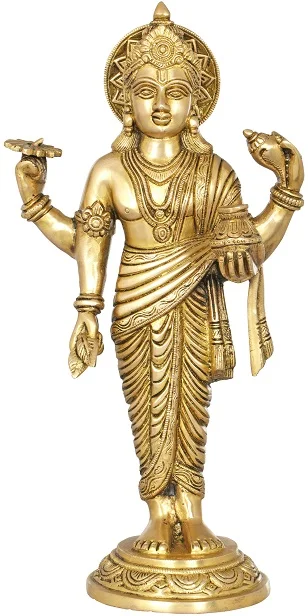
Dhanteras: A Hindu Festival
Dhanteras is a Hindu festival that marks the beginning of the five-day celebration of Diwali, the festival of lights. It is celebrated on the thirteenth lunar day of the dark fortnight in the month of Kartik, according to the Hindu calendar. The word Dhanteras is derived from two Sanskrit words: dhan, meaning wealth, and teras, meaning thirteenth. On this auspicious day, people worship Lord Dhanvantari, the god of Ayurveda and medicine, and Goddess Lakshmi, the goddess of wealth and prosperity. They also buy gold, silver, or other metal items, especially utensils, as a symbol of good luck and fortune. Dhanteras is a festival that celebrates health, wealth, and happiness in Hindu culture. Historical Roots and Influences on Dhanteras Dhanteras is a festival that has its roots in the ancient Hindu scriptures, such as the Puranas, the Mahabharata, and the Ramayana. The word Dhanteras is derived from the Sanskrit words dhan (wealth) and teras (thirteenth), indicating that it is celebrated on the thirteenth day of the dark fortnight of the month of Kartik. The festival is also known as Dhanatrayodashi, which means the thirteenth day of wealth, or Dhanvantari Trayodashi, which means the thirteenth day of Dhanvantari, the god of Ayurveda. Another source of information that suggests the pre-Vedic origin of Dhanteras is the Harappan civilization, also known as the Indus Valley Civilization, which flourished in the northwest of India from around 2500 BCE to 1900 BCE. This civilization was known for its urban planning, trade, art, and culture. It also had a sophisticated religious system that included the worship of various deities, some of whom may have influenced or been influenced by the Vedic and post-Vedic Hindu deities. One of the most prominent deities in the Harappan civilization was a horned figure, who was depicted on a seal sitting in a yogic posture surrounded by four animals: a bull, an elephant, a tiger, and a rhinoceros. This figure has been interpreted by some scholars as an early form of Shiva, who is also associated with horns, yoga, and animals. This figure may also represent Lord Dhanvantari, who is said to have emerged from the ocean along with other deities during the churning of the milk sea. The ocean may symbolize the primordial waters from which life originated, according to some ancient cosmologies. Another deity in the Harappan civilization was a female figure, who was depicted on various seals and figurines as a goddess of fertility, prosperity, and abundance. She was often shown holding or wearing flowers, plants, or grains. She was also associated with water sources such as wells or rivers. This figure has been interpreted by some scholars as an early form of Lakshmi, who is also associated with fertility, prosperity, and abundance. She is also said to have emerged from the ocean along with other deities during the churning of the milk sea. Legends of Dhanteras: King Hima's Son, Lord Dhanvantari, and Goddess Lakshmi The origin and evolution of Dhanteras can be traced back to ancient times, when various legends and stories were associated with this festival. One of the most popular legends is that of King Hima’s son, who was destined to die on the fourth day of his marriage by a snake bite, according to his horoscope. His clever wife prevented his death by keeping him awake all night and placing a heap of gold and silver ornaments at the entrance of their chamber. She also lit lamps all around the room and sang songs to entertain him. When Lord Yama, the god of death, came in the form of a snake, he was dazzled by the brightness of the lamps and the ornaments and could not enter the chamber. He sat on the pile of gold and silver and listened to the songs until dawn. He then left quietly without harming the prince. Thus, the young wife saved her husband’s life by her wit and devotion. This legend gave rise to the tradition of lighting lamps on Dhanteras night and buying gold or silver items as a protection from evil. Another legend related to Dhanteras is that of Lord Dhanvantari, who emerged from the ocean during the churning of the milk sea by the gods and demons. He carried a pot of amrita, the nectar of immortality, in one hand and a book of Ayurveda, the science of life, in the other hand. He is considered to be an incarnation of Lord Vishnu and the physician of the gods. He imparted the knowledge of Ayurveda to mankind for their well-being and cure of diseases. He is worshipped on Dhanteras as the god of health and medicine. People also pray to him for longevity and vitality. A third legend associated with Dhanteras is that of Goddess Lakshmi, who also emerged from the ocean during the churning of the milk sea by the gods and demons. She was seated on a lotus flower and held a pot of gold in her hand. She symbolized good fortune, prosperity, happiness, and wealth. She is worshipped on Dhanteras as the goddess of wealth and prosperity. People also believe that she visits every home on this day and blesses them with abundance and success. Dhanteras and Tribal Influences According to some scholars, the origin of Dhanteras can also be traced back to the tribal cultures of India, which had a close connection with nature and its elements. Some of the tribal groups that may have influenced or been influenced by the Dhanteras festival are: The Bhils, who are one of the largest tribal groups in India, mainly inhabiting the states of Rajasthan, Gujarat, Madhya Pradesh, Maharashtra, etc. They worship various nature deities, such as Ban Mata (the goddess of the forest), Dharti Mata (the goddess of the earth), etc. They also worship fire as a symbol of life and energy. They celebrate a festival called Baneshwar, which means "the master of the delta", in honor of Lord Shiva. They perform rituals and offerings to Shiva at the confluence of three rivers: Mahi, Som, and Jakham. They also light lamps and sing songs in praise of Shiva. The Gonds, who are another large tribal group in India, mainly inhabiting the states of Madhya Pradesh, Chhattisgarh, Maharashtra, Telangana, etc. They worship various nature deities, such as Bara Deo (the great god), Pharsa Pen (the god of iron), etc. They also worship fire as a symbol of purity and protection. They celebrate a festival called Akhadi or Akhati Jatra, which means "the journey of the new year", in honor of Lord Shiva. They perform rituals and offerings to Shiva at his temples or shrines. They also light lamps and dance in circles around a sacred fire. The Santhals, who are one of the oldest tribal groups in India, mainly inhabiting the states of Jharkhand, West Bengal, Bihar, Odisha, etc. They worship various nature deities, such as Marang Buru (the great mountain), Jaher Era (the goddess of the sacred grove), etc. They also worship fire as a symbol of warmth and light. They celebrate a festival called Sohrai or Sorhae, which means "the festival of cattle", in honor of Goddess Lakshmi. They perform rituals and offerings to Lakshmi at their homes or barns. They also light lamps and paint their walls with colorful patterns using rice paste.
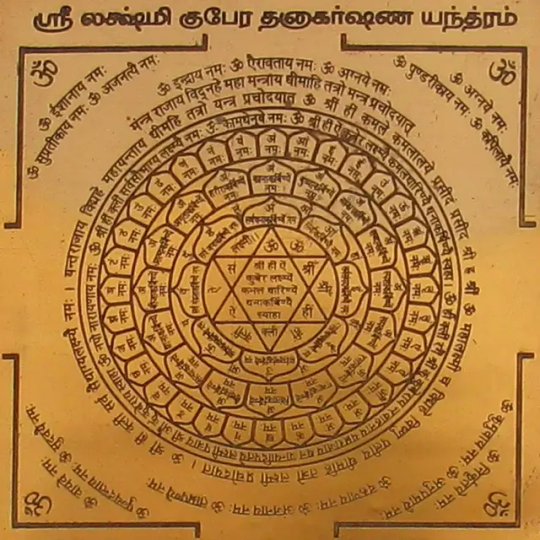
Tantric Connection: Dhanakarshana Yantra and Shakti The connection between Dhanteras and tantra can be seen in the concept of Dhanakarshana Yantra, which is a geometric diagram that is used to attract wealth and prosperity. According to tantra, Dhanakarshana Yantra is a representation of Goddess Lakshmi's energy and power. It consists of a square with four gates or doors on each side, which symbolize the four directions or aspects of wealth: dharma (righteousness), artha (material wealth), kama (desire), and moksha (liberation). Inside the square is a lotus flower with eight petals, which symbolize the eight forms or aspects of Lakshmi: Adi Lakshmi (the primal goddess), Dhana Lakshmi (the goddess of money), Dhanya Lakshmi (the goddess of grains), Gaja Lakshmi (the goddess of elephants), Santana Lakshmi (the goddess of progeny), Veera Lakshmi (the goddess of valor), Vijaya Lakshmi (the goddess of victory), and Vidya Lakshmi (the goddess of knowledge). Inside the lotus is a hexagram or star with six points, which symbolize the six attributes or qualities of Lakshmi: jnana (wisdom), shakti (power), bala (strength), aishwarya (sovereignty), veerya (courage), and tejas (splendor). Inside the hexagram is a bindu or dot, which symbolizes the essence or source of Lakshmi's energy and power. The connection between Dhanteras and tantra can be seen in the concept of Shakti, which is a form of cosmic energy that manifests in various forms and aspects. According to tantra, Shakti is the dynamic and creative aspect of Shiva, who is the static and transcendent aspect of reality. Shakti is also the power that animates and sustains all living beings and phenomena. The symbol of Shakti is a lotus flower, which represents purity, beauty, and grace. The lotus flower also symbolizes Lakshmi, who is considered to be one of the forms or aspects of Shakti. Thus, Dhanteras can be seen as a festival that celebrates the union and harmony of Shiva and Shakti, or consciousness and energy, through the worship of fire, water, gold, silver, etc. These elements represent the various manifestations and expressions of Shiva and Shakti in nature and in human life.
Symbolism and Rituals of Dhanteras
The key rituals performed on Dhanteras have symbolic significance as well. The cleaning and decorating of homes with lamps, rangoli, flowers, etc., indicate that one should purify one’s mind from negative thoughts and emotions and welcome positive energy into one’s life. The buying of gold or silver items or utensils indicate that one should invest in productive assets that can generate income or value in future. The worshipping of Lord Dhanvantari and Goddess Lakshmi indicate that one should seek their blessings for health and wealth respectively. The offering of sweets or naivedya indicate that one should express gratitude for all that one has received in life. The cultural and spiritual meaning of Dhanteras can be seen in its reflection of Hindu values and beliefs. Dhanteras celebrates the importance of health as a prerequisite for happiness and prosperity. It also celebrates the importance of wealth as a means for fulfilling one’s duties and responsibilities towards oneself, one’s family, one’s society, and one’s God. It also celebrates the importance of wisdom as a guide for using one’s wealth wisely and ethically.
Diverse Celebrations Across India and Folklore
Dhanteras is celebrated in diverse ways across India according to regional customs and traditions. In some parts of India, people also worship Lord Kuber, the treasurer of heaven, along with Goddess Lakshmi on Dhanteras. In some parts of India, people also worship cows, which are considered sacred and a source of wealth in Hindu culture. In some parts of India, people also play games of dice or cards on Dhanteras, as a reminder of the legend of Lord Shiva and Goddess Parvati, who played dice on this day and decided the fate of the world. In some parts of India, people also buy new clothes or jewelry on Dhanteras, as a symbol of prosperity and joy. There are many folklore and stories associated with Dhanteras that add to its charm and appeal. One such story is that of a poor Brahmin who was unable to buy anything on Dhanteras due to his poverty. He was advised by a sage to buy a single betel leaf and offer it to Goddess Lakshmi with devotion. He did so and was blessed by the goddess with wealth and happiness. Another story is that of a merchant who was returning home after a long journey on Dhanteras. He stopped at a village to rest for the night and was offered a room by a kind villager. He noticed that the room had no lamps or decorations and asked the villager why he did not celebrate Dhanteras. The villager replied that he was too poor to afford anything and that he had no hope for the future. The merchant felt pity for him and decided to help him. He gave him some money and asked him to buy some lamps and flowers and decorate his room. He also asked him to worship Goddess Lakshmi with faith and sincerity. The villager did as he was told and was surprised to see that his room was filled with light and fragrance. He thanked the merchant for his generosity and prayed to the goddess for his well-being. The next morning, he found that his room was filled with gold and silver coins and jewels. He realized that it was a miracle of Goddess Lakshmi and thanked her for her grace. Relevance in Contemporary Society and Tips for Celebration In contemporary times, Dhanteras has adapted to the changing needs and preferences of modern society. People now buy not only gold or silver items or utensils but also electronic gadgets, appliances, vehicles, etc., on Dhanteras, as they are considered auspicious and beneficial. People also shop online or use digital platforms for buying or gifting items on Dhanteras, as they are convenient and time-saving. People also use social media or other means of communication to wish their friends and relatives on Dhanteras, as they are easy and effective. Dhanteras has also created a significant impact on the commercial and economic sectors of society. It has boosted the demand and supply of various products and services related to Dhanteras, such as jewelry, utensils, electronics, etc. It has also generated employment opportunities for various sectors such as manufacturing, retailing, marketing, etc. It has also contributed to the growth of various industries such as e-commerce, banking, finance, etc. Dhanteras has also fostered social and community celebrations among people from different backgrounds and regions. It has brought people together in a spirit of joy and harmony. It has also encouraged people to share their wealth and happiness with others in need. It has also promoted cultural exchange and integration among people from different traditions and customs. Dhanteras is still relevant in contemporary society as it reminds us of the importance of health, wealth, wisdom, gratitude, generosity, faith, devotion, hope, joy, harmony, etc., in our lives. It also inspires us to balance our tradition with our modern lifestyle and adapt to the changing times without losing our essence. Personalized Celebrations: Tips and Ideas: Traditional gift: Sending gifts to your loved ones gold or silver coins or jewelry with images of Goddess Lakshmi or Lord Ganesha engraved on them. You can also gift them utensils made of brass, copper, silver, or steel that can be used for cooking or serving food. You can also gift them idols or pictures of Lord Dhanvantari or Goddess Lakshmi that can be placed in their homes or offices for worship. Decoration and puja suggestions: You can decorate your home or office with lamps, candles, flowers, rangoli, etc., to create a festive atmosphere. You can also draw footprints of Goddess Lakshmi with rice flour or vermilion at the entrance of your home or office to welcome her into your premises. You can perform puja in the evening by placing idols or pictures of Lord Dhanvantari and Goddess Lakshmi on a platform covered with a red cloth. You can offer them flowers, incense sticks, sweets, fruits, etc., as naivedya. You can chant mantras or sing bhajans in their praise. You can also donate some money or food items to the poor or needy as a gesture of charity. Balancing tradition with modern lifestyle: You can celebrate Dhanteras in a way that suits your convenience. Conclusion: The Vibrant Threads of Modernity and Sanatana Dharma In conclusion, Dhanteras emerges as a celebration that transcends temporal boundaries, weaving together the ancient tapestry of tradition with the vibrant threads of modernity. From its roots in Hindu scriptures and the Harappan civilization to its contemporary adaptations in the digital age, Dhanteras stands as a testament to the enduring values of health, wealth, wisdom, and community. The festival's evolution mirrors the dynamic nature of human life, emphasizing the importance of adapting to change while preserving the essence of cultural values. As individuals celebrate Dhanteras in diverse ways across India, the festival serves as a unifying force, fostering community harmony and cultural integration. Dhanteras' impact extends beyond the spiritual and cultural realms, influencing the commercial and economic sectors. Its significance is not confined to rituals but extends to personalized celebrations, where individuals strike a balance between tradition and modern lifestyle. As we navigate the intricate interplay of tradition and contemporary expression, Dhanteras remains a timeless reminder of the values that resonate across generations. It encourages individuals to reflect on health, wealth, wisdom, and joy, offering a holistic perspective that unites the ancient with the modern, ensuring that the festival's essence continues to illuminate our lives. Read the full article
#AdikkaChannels#CulturalHarmony#DhanakarshanaYantra#DhanterasCelebration#FestivalOfLights#HealthWealthWisdom#Hinduism#KingHima'sSon#LordDhanvantari#TheBhils#TheGonds#TheSanthals#TraditionAndModernity
0 notes
Text

"Kubjikā a secret goddess, having immense metaphysical depth, a large varieties of forms, and varied methods of yoga (especially those linked with the movement of vital breath), appears in the Bhairava and then the Western Kaula Tantra (Paschima-amnaya ) Traditions of the Himalayan regions during 7th century. She is variously addressed in her Tantras as :Kubjinī – the Hunchback Girl; Kubjī, Kujā, Kujī, Khañjinī – the Lame One; Vakrikā or Vakrā – the Crooked One; Ciñcinī – the Goddess residing in the Tamarind tree; Kulālikā – the Potteress; Ambā or the vernacular forms as : Avvā, Anāmā, Laghvikā; and, most common of all as Śrī – the Royal One who has as her scripture, teaching, school and tradition (anvaya, āmnāya); and as the Śrīmata. Kubjinī, a very secret goddess is worshiped in her Tantras along with Bhairava, her consort. As Kundalini, Kubjika is worshipped as the Goddess who is curled up and sleeping, waiting to be awakened. The sect of Nine Natahas is believed to have propagated the cult of Kubjika throughout Nepal and North India.
In the Kaula Tantra (Paschima-amnaya) Tradition, Devi Kubjika is worshiped with Shiva with his five faces Sadyojata; Vamadeva, Tatpurusha; Aghora and Ishana.. The hallowed mother Kubjika has six faces.
She is adorned with serpents: Karotaka as a waist band; Takshaka as a mid-riff ornament; Vasuki as garland; and, the venomous cobra Kulika as an ear ornament.
She holds in her arms as skull, a king-cobra, a crystal-bead rosary, skull-topped rod, a conch, a book, a trident, a mirror, a straight sword, a gem necklace, an ankusha (goad) and a bow. She is of fair complexion like a young jasmine flower.
The mantra of Kubjika is Om Shrim Prim Kubjike Devi Hrim Thah Svaha
As per the Kaula Tantra (Paschima-amnaya), Lord Bhairava initiates the Devi into the Kubjikā-mata-tantra, saying: Oh the Goddess of great fortune! O bestower of great bliss! (Mahābhāge Mahā-ananda-vidhāyini) The teaching that you have requested is truly astonishing and salutary (atyadbhutam anāmayam). That is kept secret by all the Rudras, Tantric heroes, and Bhairavas. Nevertheless, I will teach you that secret Tantra, which has come down through a series of transmissions,established through the line of Siddhas (Siddha mārga kramāyātaṃ Siddha paṅkti vyavasthitaṃ)..
Sādhu sādhu Mahābhāge Mahā-ananda-vidhāyini | pṛcchitaṃ yat tvayā vākyam atyadbhutam anāmayam || gopitaṃ sarva Rudrāṇāṃ vīrāṇāṃ Bhairaveṣu ca | Siddha-kramaṃ nirācāraṃ tathāpi kathayāmi te || Siddha mārga kramāyātaṃ Siddha paṅkti vyavasthitaṃ – Kubjikāmatatantra 1.44-46:
The Kaula Śhaiva Siddantha recognizes the lineage (santati) of four innately enlightened Siddhas (sāṃ-siddhika), the Masters of Four Ages (Yuga-nāthas) in the transmission (krama) of the Kaula-marga.
Abhinavagupta, in his Tantrāloka, recalls with reverence the Guru-linage (Guru-santati) , commencing with the four Siddhas, the Yuga-nāthas, together with their consorts: Khagendra and Vijjāmbā; Kūrma and Maṅgalā; Meṣa and Kāmamaṅgalā; and finally, Macchanda (Matsyendranātha) and Kuṅkuṇāmbā (Koṅkaṇā).
khagendraḥ sahavijjāmba illāri ambayā saha || vaktaṣṭir vimalo ‘nantamekhalāmbāyutaḥ purā | śaktyā maṅgalayā kūrma illāri ambayā saha || jaitro yāmye hy avijitas tathā sānandamekhalaḥ | kāmamaṅgalayā meṣaḥ kullāri ambayā saha || vindhyo ‘jito ‘py ajarayā saha mekhalayā pare | macchandaḥ kuṃkuṇāmbā ca ṣaḍyugmaṃ sādhikārakam. – Tantrāloka 29.29cd-31:
Matsyendranātha or Macchandanātha, the most iconic Siddha, is said to be primarily responsible for the spread of the Kaula-marga of the Shaiva Siddantha in this Kali Age.
Apart from Matsyendranātha, some other Siddhas were also said to have played an important role in propagation of the Kula-mārga.
The Tantric text, Devīpañcaśatikā, mentions the set of four other Siddha-couples: Niṣkriyānanda and Jñānadīpti; Vidyānanda and Raktā; Śaktyānanda and Mahānandā; and , Śivānanda and Samayā
niṣkriyānandanāthaś ca jñānadīptyā sahaikataḥ ||vidyānandaś ca raktā ca dvitīyaḥ kathitas tava | śaktyānando mahānandaḥ tṛtīyaḥ siddhapūjitaḥ || śivānando mahānandaḥ samāyātaś caturthakaḥ | khagendrādyādisiddhānāṃ kathitā gurusantatiḥ – Devīpañcaśatikā 3.15cd-17."
https://sreenivasaraos.com/tag/kubjika-tantra/
5 notes
·
View notes
Text

We may see this world as countries, cities, towns, and people that are divided by lines on a map. But the truth is that this is one world that arose within space, and that will dissolve back into space. And that every being's body that has ever habited this world is actually made up of it, and that will dissolve back into it. Nothing exists independently.
~ Chamtrul Rinpoche
"What worlds are there herein? I'll tell you. In these seas of fragrant waters, numerous as atoms in unspeakably many buddha-fields, rest an equal number of world systems.
Each world system also contains an equal number of worlds. Those world systems in the ocean of worlds have various resting places, various shapes and forms, various substances and essences, various locations, various entryways, various adornments, various boundaries, various alignments, various similarities, and various powers of maintenance.
I vow that when my life approaches its end, all obstructions will be swept away; I will see Amitabha Buddha, and be born in his land of Ultimate Bliss and Peace. When reborn in the Western Land, I will perfect and completely fulfill, without exception, these Great Vows, to delight and benefit all beings.
Inconceivable, the Buddha's body holds within it all lands.
He is present everywhere, guiding beings and teaching true Dharma.
I can penetrate the future and exhaust all eons in a single thought. In a single thought I completely enter all eons of the three periods of time.
On the tip of an extremely fine hair, appear jewelled lands of past, present and future; lands on hair tips as numerous as dust motes in all lands of the ten directions, I deeply enter, adorn, and purity.
~ The Flower Ornament Scripture: A Translation of the Avatamsaka Sutra
#buddha#buddhist#buddhism#dharma#sangha#mahayana#zen#milarepa#tibetan buddhism#thich nhat hanh#four noble truths#Padmasambhava#Guru Rinpoche#buddha samantabhadra#rainbow body#bodhisattva#amitaba buddha#dzambala#dzogchen
1 note
·
View note